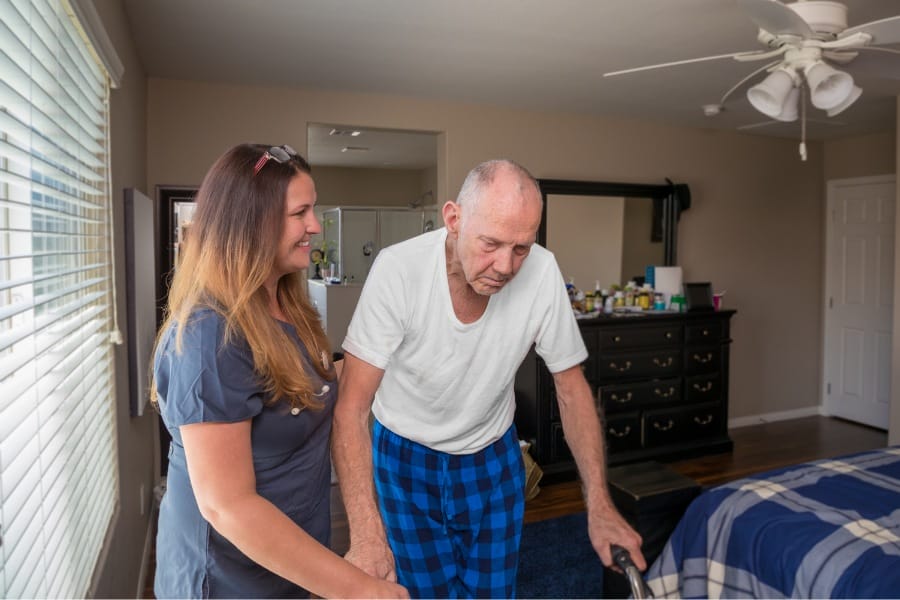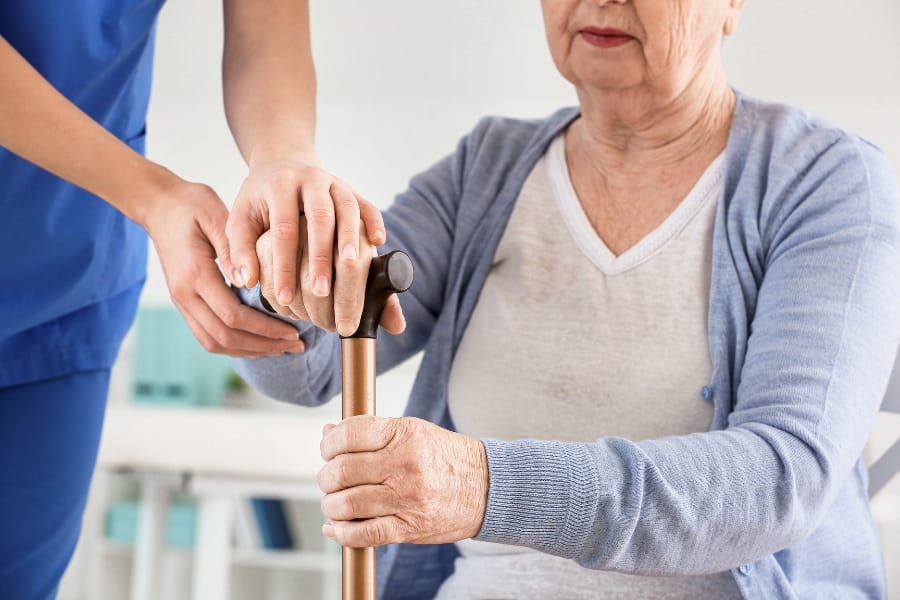Currently, there are close to one million people living with Parkinson’s disease in the US. Parkinson’s is a chronic and progressive movement disorder that affects the central nervous system, often causing tremors that worsen over time.
The cause of Parkinson’s is still unknown, though scientists have identified age as a risk factor. People over the age of 60 have a two to four percent risk of developing Parkinson’s, compared to one to two percent among the general population.
Although there is no cure, there are a variety of treatment options available to help those affected manage symptoms.
Parkinson’s disease results when vital nerve cells in an area of the brain called the substantia nigra, which is largely responsible for reward and movement, begin to malfunction. Some of these nerve cells produce dopamine, a neurotransmitter that helps in relaying messages about movement and coordination.
As the disease progresses, the brain produces less dopamine, which affects the person’s ability to control movements.
Though symptoms vary between individuals, common symptoms include tremors of the hands, arms, legs, jaw, and face; bradykinesia or slowness of movement; rigidity or stiffness of the limbs and trunk; and impaired balance and coordination.
Treatment plans depend on the degree of functional impairment, the degree of cognitive impairment, the person’s ability to tolerate medication, and the physician’s recommendations.
Let’s dive a little deeper into what exactly Parkinson’s Disease is and how to identify early symptoms of Parkinson’s Disease.
An Overview of Parkinson’s Disease
IN THIS ARTICLE

Parkinson’s disease is a progressive neurological disorder that affects the central nervous system.
It is characterized by the gradual loss of dopamine-producing neurons in the basal ganglia of the brain.
This loss of neurons leads to a decrease in dopamine levels, which causes the motor symptoms associated with Parkinson’s disease.
Causes and Risk Factors
The exact cause of Parkinson’s disease is still unknown, but it is believed to be caused by a combination of genetic and environmental factors.
While most cases of Parkinson’s disease are sporadic, meaning they occur without any known cause, some cases are inherited.
Environmental factors such as exposure to toxins and head injuries have also been linked to an increased risk of developing Parkinson’s disease.
The Role of Alpha-Synuclein and Lewy Bodies
One of the hallmarks of Parkinson’s disease is the presence of abnormal protein deposits called Lewy bodies in the brain.
These Lewy bodies are primarily composed of a protein called alpha-synuclein. It is believed that the accumulation of alpha-synuclein in the brain leads to the death of dopamine-producing neurons, which causes the motor symptoms associated with Parkinson’s disease.
Parkinson’s Disease Symptoms and Diagnosis

As with any disease or illness, it is important to be aware of symptoms and catch them early. From kidney disease to early onset dementia, you need to know what signs and symptoms to be aware of.
One common question often asked is: is Parkinson’s disease fatal? While technically it is not, the symptoms of Parkinson’s disease can lead to major complications and injuries.
Let’s discuss some of the top symptoms associated with Parkinson’s Disease.
Recognizing Early Symptoms
The early symptoms of Parkinson’s disease can be subtle and easily overlooked. Some of the early signs include tremor, rigidity, and bradykinesia.
Tremor is a common symptom and usually starts in one hand or arm. Rigidity, or stiffness of the muscles, can make movement difficult and uncomfortable. Bradykinesia, or slowness of movement, can make everyday tasks take longer to complete.
Motor and Non-Motor Symptoms
Along with motor symptoms, Parkinson’s disease can also cause non-motor symptoms. These can include any of the following:
- Depression
- Sleep disturbances
- Cognitive changes
- Changes in sense of smell
Non-motor symptoms can appear years before the onset of motor symptoms, making early diagnosis challenging.
Neurological Examination and Medical History
Diagnosis of Parkinson’s disease is primarily based on a neurological examination and medical history.
The neurological exam includes testing for tremors, rigidity, and bradykinesia. The medical history includes questions about family history, medication use, and exposure to toxins. A diagnosis of Parkinson’s disease is made when a person has two or more of the three primary motor symptoms and no other explanation for their symptoms.
Parkinson’s Disease Treatment Options
Parkinson’s disease is a chronic, progressive disorder that affects the nervous system, causing tremors, stiffness, and difficulty with movement.
While there is currently no cure for Parkinson’s disease, there are a variety of treatment options available that can help manage symptoms and improve quality of life.
Medications and Therapies
Medications are often the first line of treatment for Parkinson’s disease.
The most commonly prescribed medications for Parkinson’s disease include:
- Levodopa
- Carbidopa
- Dopamine Agonists.
Levodopa is an amino acid that is converted into dopamine in the brain, while Carbidopa helps prevent the breakdown of Levodopa before it reaches the brain.
Dopamine Agonists mimic the effects of dopamine in the brain.
Physical and occupational therapy can also be helpful in managing symptoms of Parkinson’s disease.
Exercise can help improve balance, flexibility, and strength, while occupational therapy can help individuals with Parkinson’s disease learn how to perform daily activities more easily.
Here is a more in-depth look at particular Parkinson’s Disease treatments.
Carbidopa-levodopa. Levodopa is a natural chemical that converts to dopamine in the brain. It is the most effective Parkinson’s disease medication. When it is combined with carbidopa, which protects levodopa from premature conversion to dopamine outside of the brain, it prevents or lessens side effects, which may include nausea or lightheadedness. As the disease progresses, and after years of use, the benefit from levodopa may become less stable.
Carbidopa-levodopa infusion. Duopa is a drug made up of carbidopa and levodopa, and it is administered through a feeding tube that delivers the medication directly to the small intestine in a gel form. Duopa is for patients in the more advanced stages who still respond to carbidopa-levodopa, but who have a less stable response to treatment. It is continually infused, so blood levels of the two drugs remain constant. Placement of the tube requires a small surgical procedure, and risks include the tube falling out or infections at the infusion site.
Dopamine agonists
MAO-B inhibitors. These medications include selegiline (Eldepryl, Zelapar) and rasagiline (Azilect). They help prevent the breakdown of dopamine in the brain by inhibiting the enzyme monoamine oxidase B (MAO-B), which metabolizes dopamine. Side effects may include nausea or insomnia. When MAO-B Inhibitors are added to carbidopa-levodopa, these medications increase the risk of hallucinations. These medications are not typically used in combination with most antidepressants or certain narcotics due to potentially serious but rare reactions.
Catechol-O-methyltransferase (COMT) inhibitors
Anticholinergics. These medications were used for many years to help control the tremor associated with Parkinson’s disease. The benefits are often offset by side effects such as impaired memory, confusion, hallucinations, constipation, dry mouth, and impaired urination.
Amantadine. Doctors may prescribe amantadine alone to provide short-term relief of symptoms of mild, early-stage Parkinson’s disease. It may also be given with carbidopa-levodopa therapy during the later stages of Parkinson’s disease to control dyskinesias induced by carbidopa-levodopa.
Additional Treatment Options
It is important that every individual living with Parkinson’s has a personalized therapy program specifically designed for them. In some instances, this may include a surgical procedure known as deep brain stimulation (DBS).
In DBS, electrodes are implanted into a specific part of the brain, and they are connected to a generator implanted in the chest that sends electrical pulses to the brain to reduce symptoms.
DBS can be effective for late-stage Parkinson’s or for individuals who don’t see much success with medication.
Impairments in motor function advance rapidly in the earlier stages of the disease and more slowly during the later phase.
Medications have greatly improved motor functions and each person’s ability to maintain their independence. Disabilities associated with Parkinson’s are often a result of cognitive effects, which affects individuals over the age of 70.
Surgical Treatments
In some cases, surgical treatments may be recommended for individuals with Parkinson’s disease.
Deep Brain Stimulation (DBS) is a surgical procedure that involves implanting electrodes in the brain to help regulate the electrical signals that control movement.
DBS has been shown to be effective in reducing tremors, stiffness, and other symptoms of Parkinson’s disease.
Support and Lifestyle Changes for Parkinson’s Disease
In addition to medical treatments, there are a variety of lifestyle changes and support options that can be helpful for individuals with Parkinson’s disease. Support groups can provide emotional support and practical advice, while counseling or therapy can help individuals cope with the emotional and psychological challenges of living with Parkinson’s disease.
Exercise and a healthy diet can also be beneficial for individuals with Parkinson’s disease. Regular exercise can help improve mobility, balance, and coordination, while a healthy diet can help individuals maintain a healthy weight and reduce the risk of other health problems.
Living with Parkinson’s Disease

Living with Parkinson’s disease can be challenging, but there are many things that can be done to maintain and improve one’s quality of life.
Parkinson’s disease is a progressive disorder that affects the nervous system and the parts of the body controlled by the nerves. Symptoms start slowly and worsen over time. As the disease progresses, people may have difficulty walking and talking, as well as other symptoms.
Managing Daily Life and Complications
Managing daily life with Parkinson’s disease can be challenging, but there are many strategies that can help. It is important to maintain a healthy lifestyle, including a balanced diet, regular exercise, and adequate sleep. Physical therapy and occupational therapy can also be helpful in managing symptoms and improving mobility.
Complications of Parkinson’s disease can include a variety of physical and mental health issues. Some of the most common complications include sleep problems, constipation, and sexual dysfunction. It is important to work with a healthcare provider to manage these complications and maintain overall health.
Mental Health and Emotional Changes
Parkinson’s disease can also have an impact on mental health and emotional well-being. Depression and anxiety are common in people with Parkinson’s disease, and it is important to seek treatment if these issues arise. Counseling and medication can be helpful in managing these symptoms.
In addition to depression and anxiety, Parkinson’s disease can also cause emotional changes such as apathy, irritability, and mood swings. It is important to understand that these changes are a result of the disease and not a reflection of the person’s personality. Family and friends can be a source of support during these difficult times.
Research and Future Directions
Parkinson’s disease is a complex neurodegenerative condition with a multifactorial origin. Despite decades of research, there is no cure for Parkinson’s disease, and current treatments only offer symptomatic relief. However, ongoing research provides hope for the development of more effective treatments and ultimately a cure.
Genetic research has identified several genes associated with Parkinson’s disease, and researchers are working to understand how these genes contribute to the development of the disease. This knowledge could lead to the development of targeted therapies that address the underlying causes of Parkinson’s disease.
In addition to genetic research, there is ongoing research into potential treatments for Parkinson’s disease. This includes the development of new drugs that target specific pathways involved in the disease process. Stem cell therapy is also being investigated as a potential treatment for Parkinson’s disease.
Parkinsonism, multiple system atrophy, progressive supranuclear palsy, and Lewy body dementia are all related to Parkinson’s disease and share some of the same symptoms. Research into these conditions can provide insights into the underlying mechanisms of Parkinson’s disease and may lead to the development of new treatments.
Future directions for research include the development of biomarkers that can be used to diagnose Parkinson’s disease earlier and track disease progression. This could lead to more effective treatments and ultimately a cure for Parkinson’s disease.
Skilled Nursing Care for Parkinson’s Disease
Skilled care can prevent early nursing home placement for an individual living with Parkinson’s disease and is most often provided in the home. Aside from physical and emotional support, nurses can educate patients and their families, manage and administer medications, and provide other skilled medical services.
If your loved one is living with Parkinson’s disease, a licensed nurse can provide skilled medical care, affording you peace of mind. Call us today at 650-462-1001 or click below to learn more about our skilled nursing services.
Frequently Asked Questions about Parkinson’s Disease
How can one potentially prevent the onset of Parkinson’s disease?
There is no known way to prevent Parkinson’s disease. Some believe that there are too many genetic factors. However, some studies suggest that regular exercise and a healthy diet may help reduce the risk of developing the disease. Additionally, avoiding exposure to toxins and head injuries may also reduce the risk.
What are the common symptoms associated with Parkinson’s disease?
The most common symptoms of Parkinson’s disease include tremors, stiffness, slow movement, and difficulty with balance and coordination. Other symptoms may include changes in speech, loss of smell, and sleep disturbances.
What is the typical process for diagnosing Parkinson’s disease?
There is no definitive test for Parkinson’s disease. Diagnosis is usually based on a combination of medical history, physical examination, and neurological testing. A doctor may also order imaging tests, such as a CT scan or MRI, to rule out other conditions.
At what age does Parkinson’s disease usually manifest?
Parkinson’s disease usually manifests in people over the age of 60. However, it can occur in younger people as well.
What are the current treatment options for Parkinson’s disease?
There is no cure for Parkinson’s disease, but there are several treatments available to help manage symptoms. These may include medications, such as levodopa, and deep brain stimulation surgery.
What is the expected prognosis after a Parkinson’s disease diagnosis?
The prognosis for Parkinson’s disease varies from person to person. Some people may experience only mild symptoms, while others may experience more severe symptoms that significantly impact their quality of life.
What’s the life expectancy of someone with Parkinson’s disease?
The life expectancy of someone with Parkinson’s disease is generally the same as someone without the disease. However, the disease may increase the risk of other health complications, such as pneumonia, which can impact life expectancy.
What happens if Parkinson’s goes untreated?
If Parkinson’s disease goes untreated, symptoms may gradually worsen over time, making it more difficult to manage. Additionally, untreated Parkinson’s disease may increase the risk of other health complications, such as depression and dementia.
Can you live with Parkinson’s without medication?
It is possible to live with Parkinson’s disease without medication, but it may be difficult to manage symptoms without treatment. Medications can help reduce symptoms and improve quality of life for people with Parkinson’s disease.
Sources
“What is Parkinson’s Disease?” Parkinson’s Disease Foundation, 2016
Parkinson’s Disease and Related Movement Disorders Center,” University of Maryland Medical Center, 2016.
Connolly, Barbara, “Pharmacological Treatment of Parkinson Disease,” JAMA, 2014;311(16):1670-1683
Parkinson’s Disease – Treatments and Drugs,” Mayo Clinic, July 7, 2015
Obeso JA, Rodriguez-Oroz MC, Goetz CG, Marin C, Kordower JH, Rodriguez M, Hirsch EC, Farrer M, Schapira AH, Halliday G (May 2010). “Missing pieces in the Parkinson’s disease puzzle“. Nat. Med. 16 (6): 653–61.
Poewe W (December 2006). “The natural history of Parkinson’s disease“. J. Neurol. 253 (Suppl 7): VII2–6.
Schrag, A., “Caregiver-burden in parkinson’s disease is closely associated with psychiatric symptoms, falls, and disability,” Parkinson’s and Related Disorders, January 2006, Volume 12, Issue 1, Pages 35–41
Penner, S., “Nurses and Parkinson’s Disease Part III: Roles and Opportunities,” Nursing, August 12, 2014.






